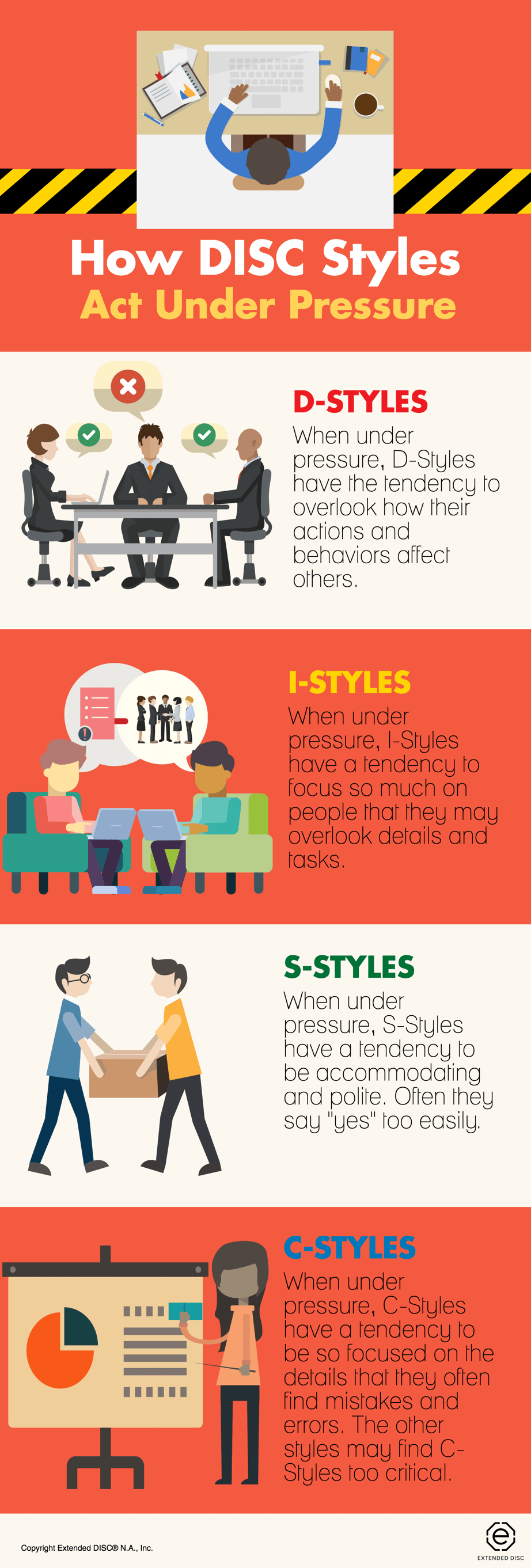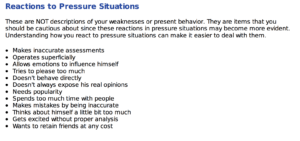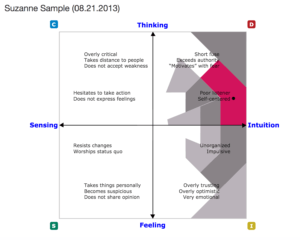When under pressure, your natural DISC style shines through your behaviors. You can use your DISC Assessment results to adapt your style to best suit pressure settings.
A person's DISC style is likely to show up when you are under pressure. Some may lose track of details. Some can snap at their peers when feeling stressed. When we feel strong emotions or pressure, we often become more of who we really are. Since we need focus and energy to manage the pressure, stress, and strong emotions, we don't have the same energy and ability to focus on the constant adaptions we make to be successful. Hence, we say that "strong emotions are the enemies of behavioral modification". DISC assessment results help us deal with how we may behave when we are under pressure.
The image below gives you an overview of how each of the 4 DISC profile types tend to act under pressure. Your DISC assessment results go in depth as to what are the behaviors that tend to show up when we are stressed. They inform you on the specific behaviors that you encounter in pressure situations. These behaviors are natural to your DISC style. Isn't easier to revert back to the behaviors that don't require you to think or use more energy? However, reverting to our natural style can also get us into trouble. Understanding the natural behaviors that you could experience in pressure settings helps you deal with, and prepare for them.

Our DISC Assessments can help you understand how your DISC style acts under pressure. Understanding how you act under pressure can help you better manage your style. How do you react to pressure situations?
Your DISC assessment results show you at least two ways you tend react to pressure. The first option (below) shows the behaviors, based on your DISC style, that appear for you in pressure situations. These behaviors vary from person-to-person depending on their DISC Style. Remember, that not the items listed apply to every setting. They are not weaknesses, but you should be cautious because they tend to show up when you feel stressed. However, experience, different settings, and practice may also need to be factored in.
One of the best ways to use the Reactions to Pressure Situations section is to identify a few from the list. You identify the relevant behaviors that show up when you feel pressured. Now, what would you do differently in the future? How would you adapt your DISC style to avoid behaviors that get you into trouble?

You can also use the visual DISC Model to identify your reaction to pressure based on your DISC Style.
The second graphic (below) is the DISC 4 Quadrant Model focusing on when a person may overuse his/her DISC style. This DISC model provides a visual image on how your DISC style shows up under pressure. This is the Extended DISC Comfort Zone Diamond. The DISC map has behaviors that show up under pressure for each of the four DISC quadrants.
The pink shaded area is a person's comfort zone. Pressure behaviors in the pink zone are most likely to show up in someone with your DISC style. The gray shaded zones also show pressure behaviors, but they tend to show up in certain settings. Lastly, the areas in the white zone displays pressure behaviors that are not likely to occur for your DISC style.

The key takeaway from your DISC assessment results should be to adjust your behaviors!
There is no denying that when you are under pressure, it is difficult to think rationally about your behaviors. Rational thinking about adjusting your behaviors takes time and effort. The first step in this process is to actually recognize your natural behaviors. When you take the time to recognize your natural behaviors, you will then successfully deal with them. However, adjusting your behavior shouldn't stop at how you act under pressure. Your DISC assessment results give you the information to adjust your communication, decision-making, and more! Our DISC assessments can also include information to adjust your behavior in a leadership role, customer service role, and more with our report customization option!
Contact Extended DISC today if you are looking to adjust your behavior for more successful interactions!
